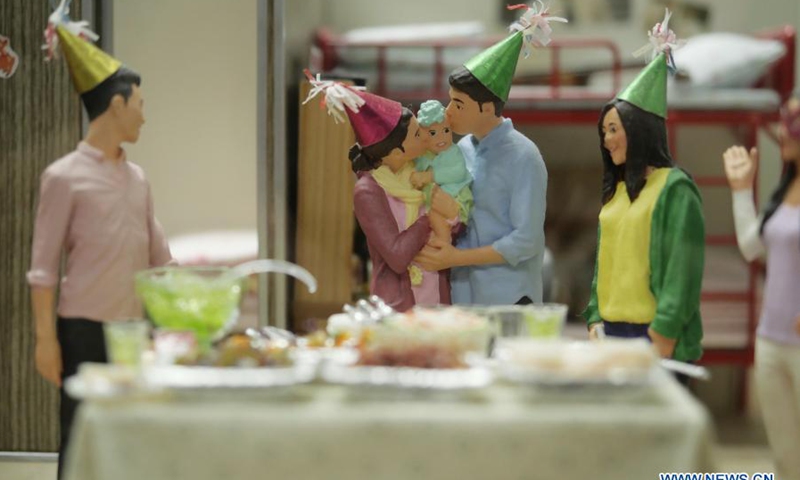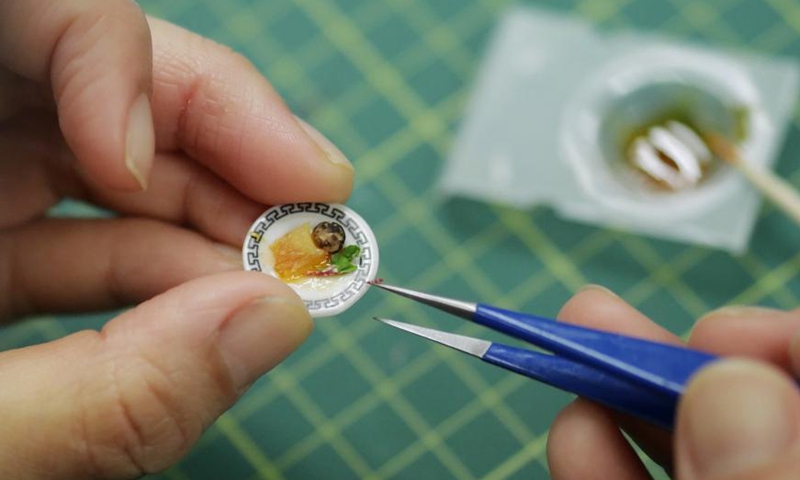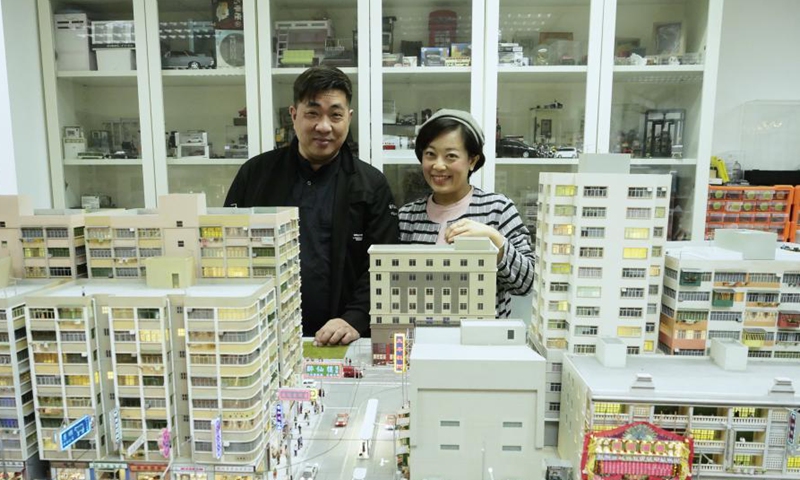Feature: Childhood memories of Hong Kong reshaped into lilliputian world by miniature artists
Source: Xinhua Published: 2020/12/27 20:37:42

Photo taken on Dec. 4, 2020 shows miniature models created by miniature artists Tony Lai and Maggie Chan in Hong Kong, south China. (Xinhua/Wang Shen)

Miniature artist Maggie Chan makes a miniature model at the studio in Hong Kong, south China, on Dec. 4, 2020. (Xinhua/Wang Shen)

Photo taken on Dec. 4, 2020 shows miniature models created by miniature artists Tony Lai and Maggie Chan in Hong Kong, south China. (Xinhua/Wang Shen)

Miniature artists Tony Lai and Maggie Chan pose for photos at their studio in Hong Kong, south China, on Dec. 4, 2020. (Xinhua/Wang Shen)
At seven o'clock in the morning, housewives rushed to a shared kitchen in the open corridors in the center of "H" shaped blocks of buildings, gossiping while preparing breakfast, with the sound of fire alarms triggered by old-fashioned kerosene stoves ringing in the background.This is one of Tony Lai's most precious childhood memories from the 1960s when he was living with his family in a seven-story building in Shau Kei Wan, the oldest public housing estate in Hong Kong.
While the rest of the world is moving forward, Hong Kong's miniature artists are taking a leaf from the past and handing it back to the present in the magical world of Lilliput.
Lai, 53, and Maggie Chan, 46, have been miniature artists for more than 10 years. One good at building large models, the other making tiny dishes as small as fingernails. They "met" each other via an email during a miniature art exhibition in 2007 before bonding into a perfect team.
Hong Kong's decades-old, but now-disappearing scenes like old-school barbershops, newspaper stalls, herbal tea shops, and cart stalls selling street food outside the theaters, are their beloved diorama themes.
"Every piece of the miniature artwork is a love letter to Hong Kong," Carmen Poon, chairperson of Joyful Miniature, told Xinhua. The objects are mostly about Hong Kong people's everyday lives, which distinguish themselves from the rest of the world, she said.
Miniature art, whose history can be dated back to European royal families in the medieval ages, condenses paintings, engravings or sculptured items into minimal sizes with their details preserved. The Hong Kong artists, however, have found their own way to reenact the lives of ordinary Hong Kong people.
Mount Davis Squatters, one of Lai's most intricate pieces, depicts people going about their daily chores in a once dilapidated village. Lai got the inspiration from his childhood experience of taking the ferry to Lamma Island with his father, where he saw the now-demolished wooden houses in the village.
"Hong Kong is changing rapidly and a lot of things have disappeared," said Chan. "Miniature art is more like a three-dimensional history book, through which we can keep our memories."
The number of newspaper hawkers operating in Hong Kong has declined rapidly from highs reached in the 1990s, according to the Food and Environmental Hygiene Department in Hong Kong. The once-iconic State Theater once lined with cart stalls in North Point has also closed.
Instead of merely focusing on creative imagination, Chan said making art existing or having once existed in real life can resonate with the audience by striking them with a "sense of belonging."
"Miniature art takes only a tiny place while including a much bigger picture about the real world," said Poon. The small size makes it easier to survive in Hong Kong, but for the artists working full time in Hong Kong, the business still faces constraints and challenges.
Compared with artists in other places, they are confronted with pressures from limited space, high rental costs and living expenses, which have pushed them to work in a high-efficiency Hong Kong style.
"After a close examination of the completed work, I always find room for improvement to make it more perfect," said Lai, adding that their daily income can barely cover the rental costs if he focuses too much on quality ahead of strict deadlines.
Not having the budget to launch their business, Lai and Chan sold 10 of their works in 2017 to cover the daily operating expenditure of the newly-opened studio.
Their 100-square meter studio in an industrial building in the Kowloon district, sometimes doubles as Lai's bedroom during the busiest times, when he can only sleep for a couple of hours.
While striking a subtle balance, their business has still been beset by the COVID-19 pandemic this year. "Some of our orders were canceled. You never know what will happen next year. It is hard to say," he mused.
Lai and Chan are two of the few full-time craftspeople who have survived, as the profession can hardly make ends meet, despite the hard work that they have put in.
Though hurting his hands has become normal for Lai since he stepped into the industry, the art is no longer all about traditional craftsmanship. 3D printing has been applied nowadays, along with augmented reality (AR) technologies in exhibitions.
"We are doing our best to reproduce the things we love to inform the younger generation and give the old people a taste of the past," said Chan. "I really love that."
Lai's dream is to make a long, bustling street stretching from the coast to the mountain top with shops, public housing estates and amusement parks.
"I am trying to work more and keep more memories while I am still capable," Lai said, pointing at some of his grey hair, with a bandaged right index finger.
Lai sometimes heads to the rooftop of the industrial building during his most stressful times, carrying several cans of beer, where he takes a break and looks down at the city which feels far below and appears just like one of his miniature pieces of art.
Posted in: CHINA